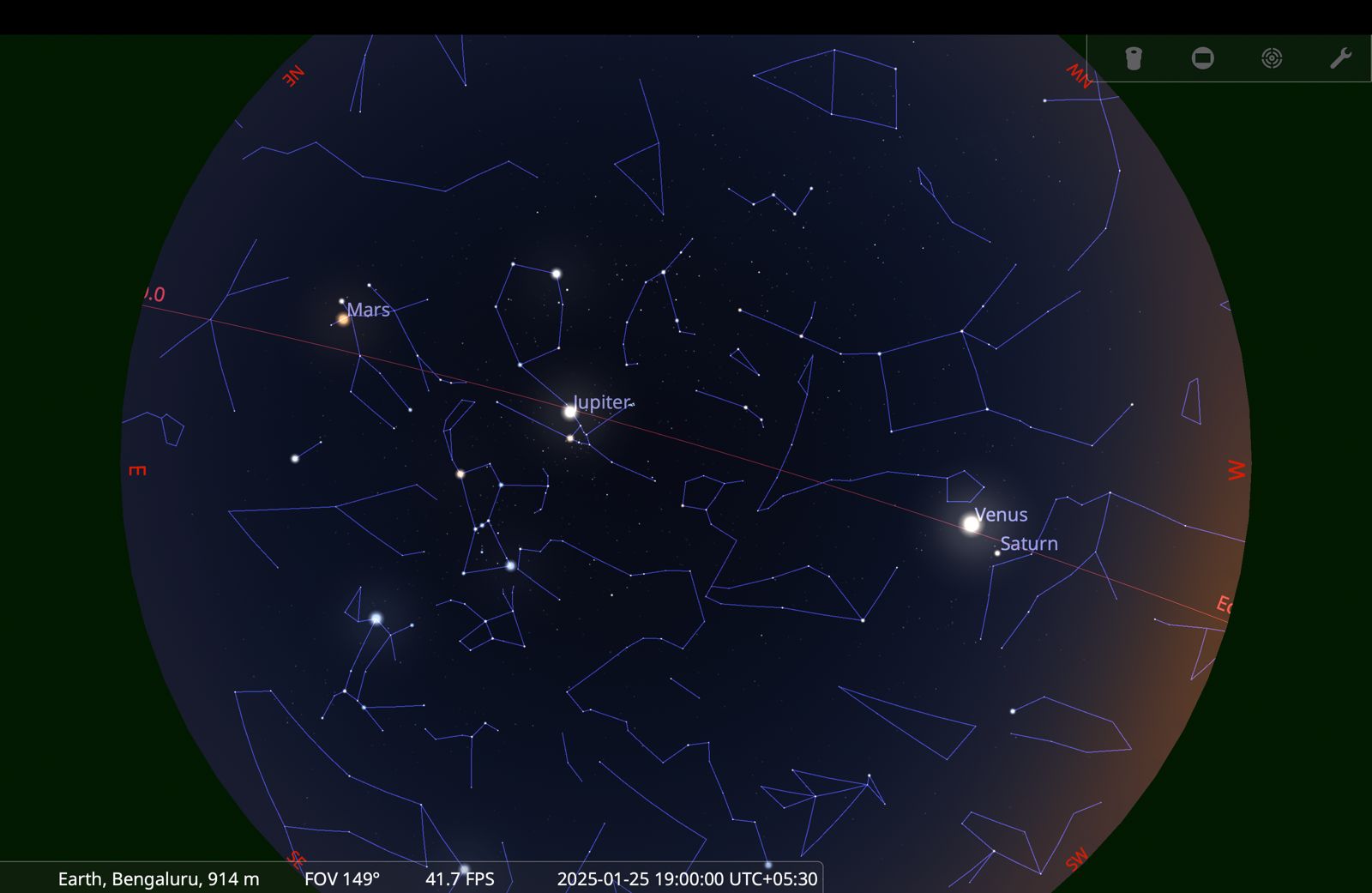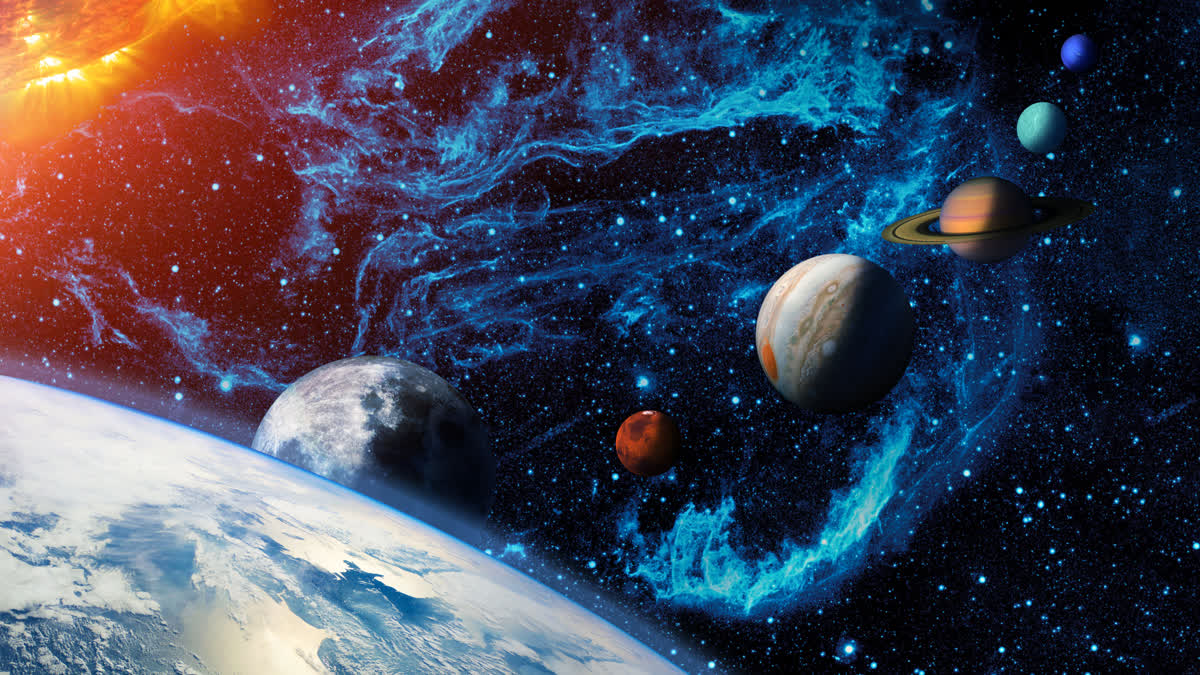By Anubha Jain
Bengaluru: It is always thrilling to see our neighbouring planets in the night sky. The experience becomes even better when multiple planets are visible at the same time. The current planetary alignment, referred to as a "planetary parade", offers a unique opportunity for skywatchers to witness four of our solar system's planets — Venus, Saturn, Jupiter, and Mars — simultaneously visible in the evening sky with the naked eye. This alignment can be seen worldwide and the planets will be visible together in the evening sky after sunset.
The Indian Institute of Astrophysics (IIA) states that the alignment of four planets forming an arc in the zodiacal belt is currently visible and will remain so until early February. While this alignment is not rare or particularly special, it is a captivating sight. Over the coming days, you’ll have an incredible opportunity to observe Venus with its silverish hue, Saturn appearing yellowish, Jupiter whitish, and Mars radiating a reddish glow— all at the same time.
Planetary Parade: Where to look
Currently, if we observe the western sky about an hour after sunset, the brightest object in the sky is Venus which is about 30 degrees above the horizon. Next to Venus, the yellow star-like object is Saturn. Slightly higher in the eastern sky is Jupiter and further east of Jupiter a bright red object is Mars.
In the early morning, just before sunrise, you can observe Mercury rising in the eastern sky. Later in March, Mercury will shift to the evening sky. Currently, Uranus and Neptune are also visible in the night sky, but unlike the other planets, they cannot be seen with the naked eye and require a telescope for observation.
A closer look at the phenomena: Hype vs reality
The eight planets in the solar system revolve around the Sun roughly on the same plane. From Earth, they appear to move within a narrow band across the sky, resembling a giant bangle. The orbits of these planets around the Sun are nearly in the same plane, each inclined only by a few degrees from the Ecliptic-- the apparent path of the Sun in the sky. Therefore, as seen from Earth, the planets' positions will always align along this plane.

Niruj Mohan Ramanujam, the head of the outreach section at the Indian Institute of Astrophysics (IIA), stated in an exclusive interview with ETV Bharat that as the planets revolve around the Sun in their orbits, some become visible in the evening while others are visible in the morning, depending on their positions. Occasionally, most of them can appear on one side of the Sun as seen from Earth. The positions of the planets keep changing over time. According to Ramanujam, this current alignment is a special occasion but not a rare one.
Contrary to what many social media posts claim, Ramanujam said that planets do not need a special day to align.
"Such alignments happen regularly and are not rare occurrences. The idea that these alignments happen once in a million years, as suggested in some viral social media messages, is entirely false. These types of alignments can be predicted and observed each year, and the recent alignment from June 3rd to June 9th, 2024, was another example," he said.
Since all the planets revolve around the Sun roughly in the same plane, the apparent path of the planets, the Sun, and the Moon in our sky lie within a 'great circle' centred on us called the zodiacal belt.
"This belt and the Ecliptic are divided into 12 zodiacal constellations. As planets travel along their orbits, they remain within this zone, making it look as though they move in a giant circle around us. When most of the planets are closer together than usual, they appear in a line, or rather, an arc in the sky. There is no simple interval or regularity in this planet parade but the planetary positions can be predicted accurately," he explained.
Talking about the window or how long it remains, Ramanujam said that the planets move at different speeds in their orbits depending on their distance from the Sun. The farther away a planet is from the sun the slower it moves. This makes Mercury, Mars, and Venus move faster in our sky while Jupiter and Saturn move at a slower speed. Although the current alignment of Venus, Saturn, Jupiter, and Mars is visible over several weeks, the positions of the planets will shift gradually, and at different speeds. From now onwards Saturn will be seen sooner after sunset. These are natural cycles that happen.
This alignment provides an excellent chance for skywatchers to marvel at the beauty of our planetary neighbours. With the current alignment, the visible planets and their changing positions over the next few weeks offer a stunning view of the night sky.



